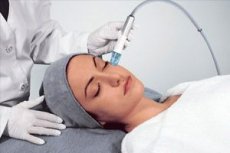Medical expert of the article
New publications
Oxygen therapy and oxygen microdermabrasion
Last reviewed: 08.07.2025

All iLive content is medically reviewed or fact checked to ensure as much factual accuracy as possible.
We have strict sourcing guidelines and only link to reputable media sites, academic research institutions and, whenever possible, medically peer reviewed studies. Note that the numbers in parentheses ([1], [2], etc.) are clickable links to these studies.
If you feel that any of our content is inaccurate, out-of-date, or otherwise questionable, please select it and press Ctrl + Enter.

Oxygen therapy (oxygen therapy, needle-free oxymesotherapy) is a modern method of saturating the surface layers of the epidermis with oxygen supplied to the skin under pressure in a concentrated form. To ensure normal vital processes of the skin, it must receive a sufficient amount of glucose, amino acids, fatty acids, and oxygen. In case of a deficiency of the latter, metabolic reactions proceeding by the oxidative type (glycolysis, etc.) slow down. In addition, a lack of oxygen in the skin causes the accumulation of intermediate products of unfinished chemical reactions in the cells. The search for new methods of oxygenation and nutrition of the skin has been and remains a relevant task in cosmetology.
The ideal method of delivering oxygen and active preparations must meet the following requirements: the stratum corneum of the epidermis is not damaged, the active ingredients penetrate into the deep layers of the skin, where a depot of the preparation is formed, which ensures a longer duration and gradual effect.
An interesting oxygenation technique came to cosmetology from classical medicine. Based on the technology that has been used for insulin injections and vaccinations for over 30 years, in 1994 the German naturopath Lothar Bode developed a new method of introducing cosmetic preparations into the deep layers of the epidermis using compressed oxygen.
Oxygen is a unique substance used in medicine externally, orally, by inhalation, in pure form and in the form of solutions. This diversity allows us to recommend oxygen for many nosologies, while choosing the most effective and safe options. Currently, almost all methods are designed to obtain oxygen from the surrounding air using concentrators, while the inconveniences and risks associated with the use of cylinder oxygen disappear.
Features of action
It is known that oxygen is capable of performing the following functions:
- Stimulates tissue microcirculation and cellular metabolism
- Enhances tissue regeneration.
- Strengthens the skin's antibacterial and immune defenses
- Used in the prevention and treatment of acne.
- Restores complexion.
Oxygen has a complex beneficial effect on the body (when inhaled):
- Strengthens the immune system.
- Reduces blood pressure.
- Normalizes sleep
- Reduces stress.
- Normalizes metabolism.
Oxygen therapy technique
A cosmetic preparation is applied to the skin surface (whether a preparation is suitable for oxygen therapy is largely determined by the characteristics of the preparation composition), which can be introduced into the skin using oxygen. Preparations must be hypoallergenic, which is naturally associated with the safety of the technique, low-molecular, which affects the speed of absorption, and at the same time have antioxidant activity, which is necessary due to the high degree of mitochondrial activity of keratinocytes of the damaged epidermis. It is also necessary to combine the convenience of the form and the stability of the chemical composition of the preparation (a matter of production quality). Then, oxygen is supplied to the skin surface from a special tip in pulse mode under a pressure of about 2 atmospheres (this value was recognized as optimal as a result of numerous experiments). The gas "pushes" the molecules of the cosmetic product through the intercellular spaces and allows them to reach the deep layers of the epidermis, where they are most useful. Oxygen used to introduce cosmetic preparations deep into the skin is captured by a special concentrator from the surrounding air. The air is drawn in and purified in a series of filters (including ultraviolet). At the outlet of the concentrator, a gas mixture is obtained, consisting of 98% oxygen.
It has been confirmed that oxygen therapy accelerates the penetration of active substances into the epidermis (in 2-14 minutes they penetrate to the same depth as in 1 hour with simple application to the skin). Modern oxygen therapy devices have additional capabilities, such as oxygen irrigation, oxygen inhalation, and microdermabrasion mode.
Oxygen irrigation ("oxy-spray")
This method is completely similar to the one described above, except that it is carried out without the use of cosmetics and without contact with the skin. "Oxyspray" is effective in cases where it is necessary to stimulate regeneration processes: for example, after microdermabrasion, aggressive peeling, plastic surgery and some dermatological diseases.
Oxygen inhalation (inhalation oxygen therapy) is the inhalation of air enriched with oxygen. The procedures are carried out in sessions of 10-60 minutes (with intervals from 20 minutes to several hours). Oxygen inhalation can be carried out independently or in combination with other methods, such as aromatherapy. Pure oxygen stimulates metabolic processes in the body, and selected aromatic oils act on an emotional and psychological level. The procedure is simple: a breathing mask is placed on the patient's face, from which the mixture comes. It is advisable to prescribe oxygen inhalations for injuries and diseases of the musculoskeletal system, fatigue, chronic stress, trophic ulcers, burns, intoxications, long-term non-healing wounds, damage to the oral mucosa and other conditions.
Oxygen microdermabrasion
Oxygen in the crystal flow provides gentle peeling, reduces the likelihood of side effects, has a pronounced antibacterial, regenerating and metabolic effect.
Indications:
- "stressed" skin;
- smoker's skin;
- "mature" skin;
- prevention and treatment of signs of skin aging;
- hyperpigmentation;
- acne;
Alternative methods: mesotherapy, phonophoresis, electrophoresis, microcurrent therapy.
Advantages of the method:
- absence of pain;
- comfort of the procedure;
- no damage to the skin (non-invasive method);
- wide range of indications;
- combination with other hardware techniques (microcurrent therapy, vacuum techniques, microdermabrasion)


 [
[